Human Resource Metrics: Data, Performance, and Storytelling Analysis
VerifiedAdded on 2020/05/16
|7
|1537
|52
Homework Assignment
AI Summary
This assignment delves into the significance of human resource metrics and their application in performance management. It begins by defining performance management systems and emphasizing the importance of using relevant data over convenient data for accurate assessments. The assignment then explores the negative impacts of using incorrect data in HR, including ineffective recruitment, reduced productivity, non-compliance, and employee turnover, using real-world examples to illustrate these points. Furthermore, it highlights the power of storytelling in HR, outlining how data can be transformed into compelling narratives to motivate and influence employees effectively. The process of storytelling is broken down into data collection, data reduction, story crafting, and real-life application. The assignment concludes by reiterating the value of relevant data in making informed decisions and improving organizational outcomes, supported by a Harvard business study review. The assignment covers various aspects of HR metrics, including performance management, data analysis, and storytelling, to showcase the importance of data-driven decision-making within the human resources field.
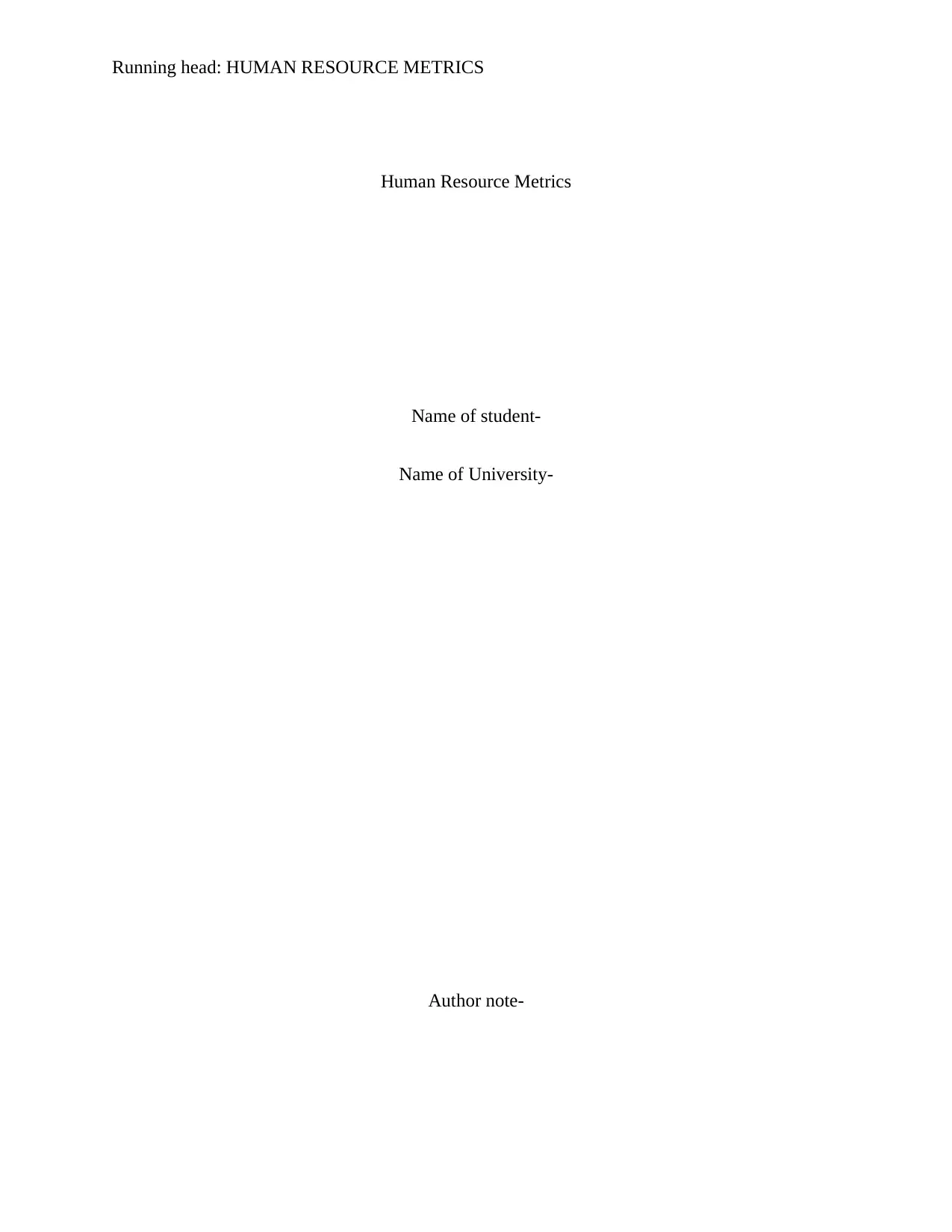
Running head: HUMAN RESOURCE METRICS
Human Resource Metrics
Name of student-
Name of University-
Author note-
Human Resource Metrics
Name of student-
Name of University-
Author note-
Paraphrase This Document
Need a fresh take? Get an instant paraphrase of this document with our AI Paraphraser
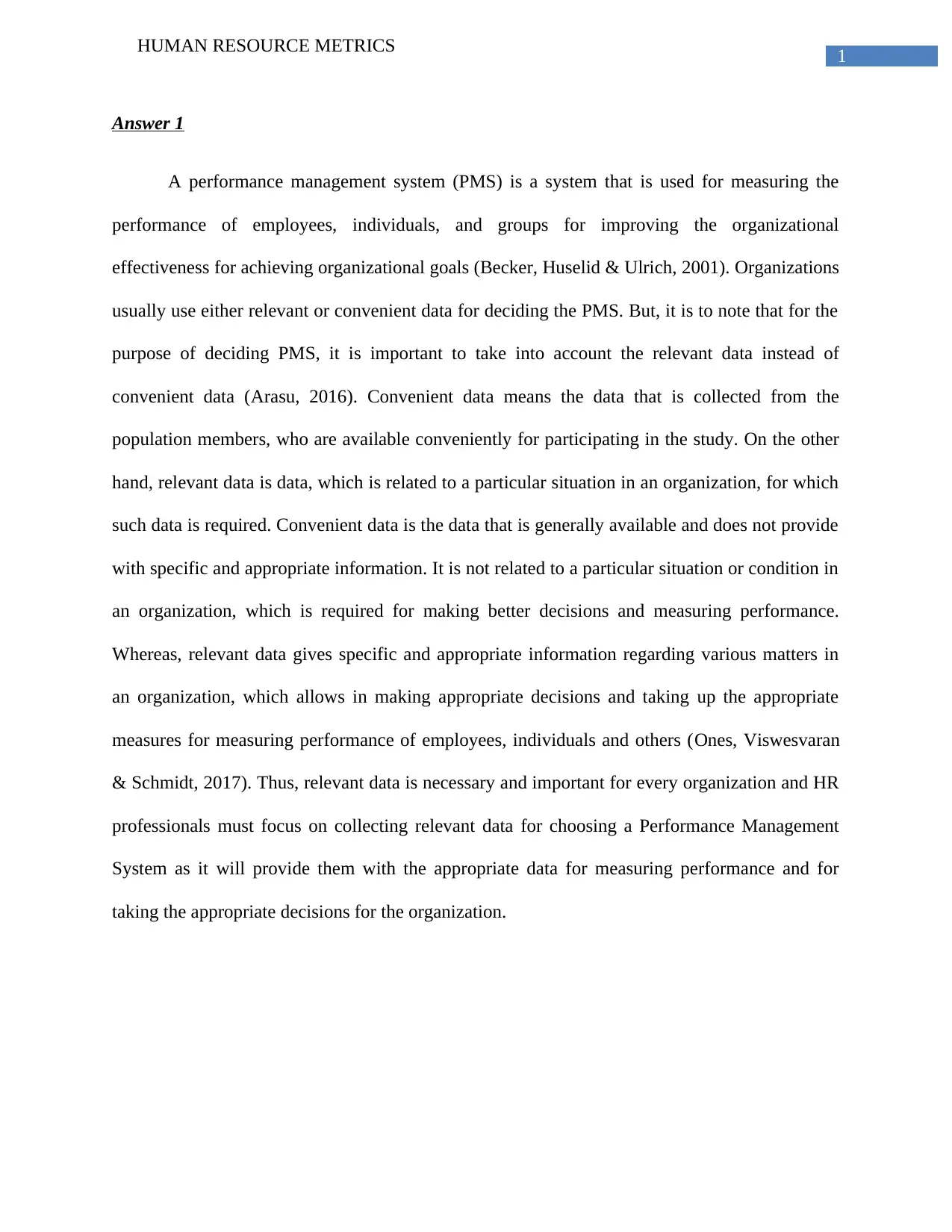
1
HUMAN RESOURCE METRICS
Answer 1
A performance management system (PMS) is a system that is used for measuring the
performance of employees, individuals, and groups for improving the organizational
effectiveness for achieving organizational goals (Becker, Huselid & Ulrich, 2001). Organizations
usually use either relevant or convenient data for deciding the PMS. But, it is to note that for the
purpose of deciding PMS, it is important to take into account the relevant data instead of
convenient data (Arasu, 2016). Convenient data means the data that is collected from the
population members, who are available conveniently for participating in the study. On the other
hand, relevant data is data, which is related to a particular situation in an organization, for which
such data is required. Convenient data is the data that is generally available and does not provide
with specific and appropriate information. It is not related to a particular situation or condition in
an organization, which is required for making better decisions and measuring performance.
Whereas, relevant data gives specific and appropriate information regarding various matters in
an organization, which allows in making appropriate decisions and taking up the appropriate
measures for measuring performance of employees, individuals and others (Ones, Viswesvaran
& Schmidt, 2017). Thus, relevant data is necessary and important for every organization and HR
professionals must focus on collecting relevant data for choosing a Performance Management
System as it will provide them with the appropriate data for measuring performance and for
taking the appropriate decisions for the organization.
HUMAN RESOURCE METRICS
Answer 1
A performance management system (PMS) is a system that is used for measuring the
performance of employees, individuals, and groups for improving the organizational
effectiveness for achieving organizational goals (Becker, Huselid & Ulrich, 2001). Organizations
usually use either relevant or convenient data for deciding the PMS. But, it is to note that for the
purpose of deciding PMS, it is important to take into account the relevant data instead of
convenient data (Arasu, 2016). Convenient data means the data that is collected from the
population members, who are available conveniently for participating in the study. On the other
hand, relevant data is data, which is related to a particular situation in an organization, for which
such data is required. Convenient data is the data that is generally available and does not provide
with specific and appropriate information. It is not related to a particular situation or condition in
an organization, which is required for making better decisions and measuring performance.
Whereas, relevant data gives specific and appropriate information regarding various matters in
an organization, which allows in making appropriate decisions and taking up the appropriate
measures for measuring performance of employees, individuals and others (Ones, Viswesvaran
& Schmidt, 2017). Thus, relevant data is necessary and important for every organization and HR
professionals must focus on collecting relevant data for choosing a Performance Management
System as it will provide them with the appropriate data for measuring performance and for
taking the appropriate decisions for the organization.
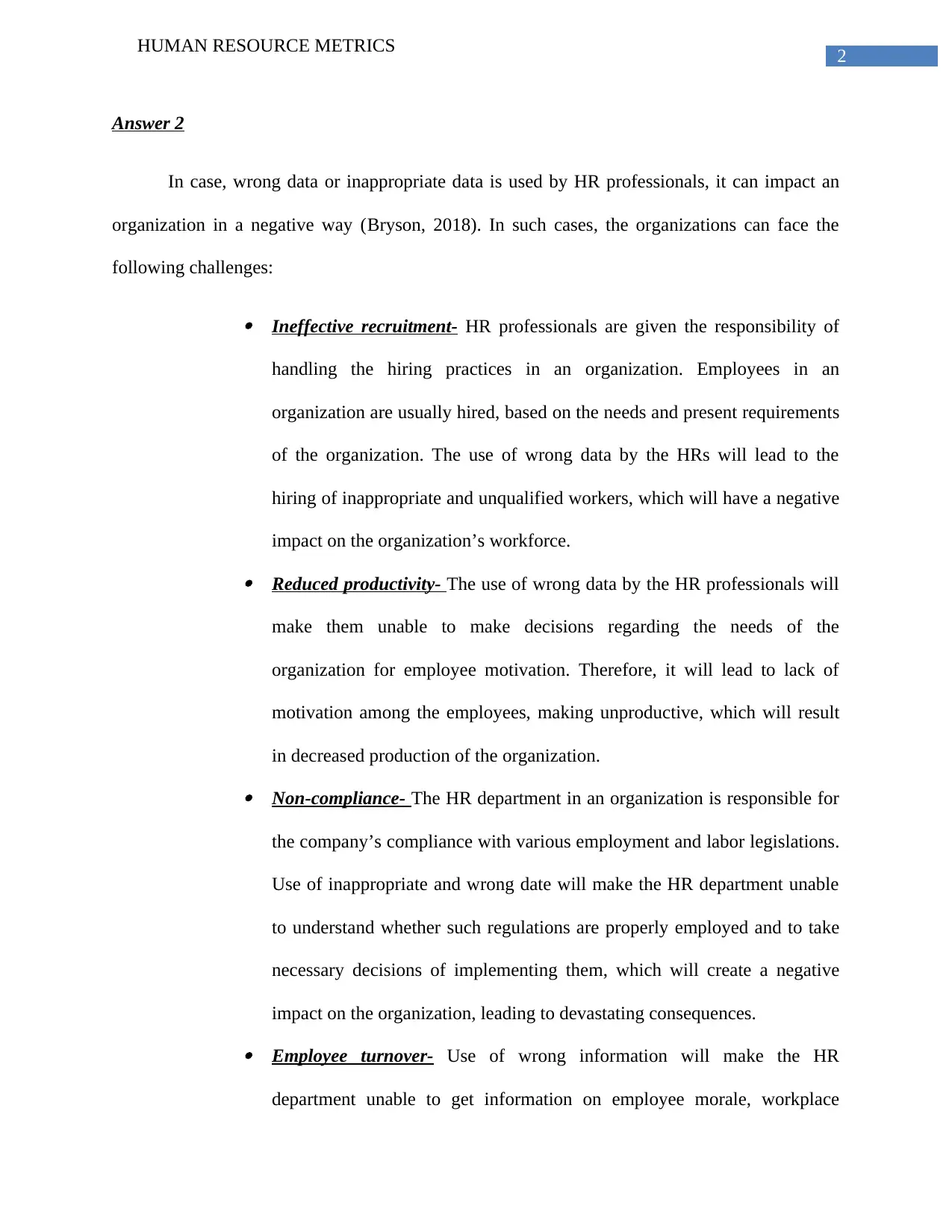
2
HUMAN RESOURCE METRICS
Answer 2
In case, wrong data or inappropriate data is used by HR professionals, it can impact an
organization in a negative way (Bryson, 2018). In such cases, the organizations can face the
following challenges: Ineffective recruitment- HR professionals are given the responsibility of
handling the hiring practices in an organization. Employees in an
organization are usually hired, based on the needs and present requirements
of the organization. The use of wrong data by the HRs will lead to the
hiring of inappropriate and unqualified workers, which will have a negative
impact on the organization’s workforce.
Reduced productivity- The use of wrong data by the HR professionals will
make them unable to make decisions regarding the needs of the
organization for employee motivation. Therefore, it will lead to lack of
motivation among the employees, making unproductive, which will result
in decreased production of the organization.
Non-compliance- The HR department in an organization is responsible for
the company’s compliance with various employment and labor legislations.
Use of inappropriate and wrong date will make the HR department unable
to understand whether such regulations are properly employed and to take
necessary decisions of implementing them, which will create a negative
impact on the organization, leading to devastating consequences.
Employee turnover- Use of wrong information will make the HR
department unable to get information on employee morale, workplace
HUMAN RESOURCE METRICS
Answer 2
In case, wrong data or inappropriate data is used by HR professionals, it can impact an
organization in a negative way (Bryson, 2018). In such cases, the organizations can face the
following challenges: Ineffective recruitment- HR professionals are given the responsibility of
handling the hiring practices in an organization. Employees in an
organization are usually hired, based on the needs and present requirements
of the organization. The use of wrong data by the HRs will lead to the
hiring of inappropriate and unqualified workers, which will have a negative
impact on the organization’s workforce.
Reduced productivity- The use of wrong data by the HR professionals will
make them unable to make decisions regarding the needs of the
organization for employee motivation. Therefore, it will lead to lack of
motivation among the employees, making unproductive, which will result
in decreased production of the organization.
Non-compliance- The HR department in an organization is responsible for
the company’s compliance with various employment and labor legislations.
Use of inappropriate and wrong date will make the HR department unable
to understand whether such regulations are properly employed and to take
necessary decisions of implementing them, which will create a negative
impact on the organization, leading to devastating consequences.
Employee turnover- Use of wrong information will make the HR
department unable to get information on employee morale, workplace
⊘ This is a preview!⊘
Do you want full access?
Subscribe today to unlock all pages.

Trusted by 1+ million students worldwide
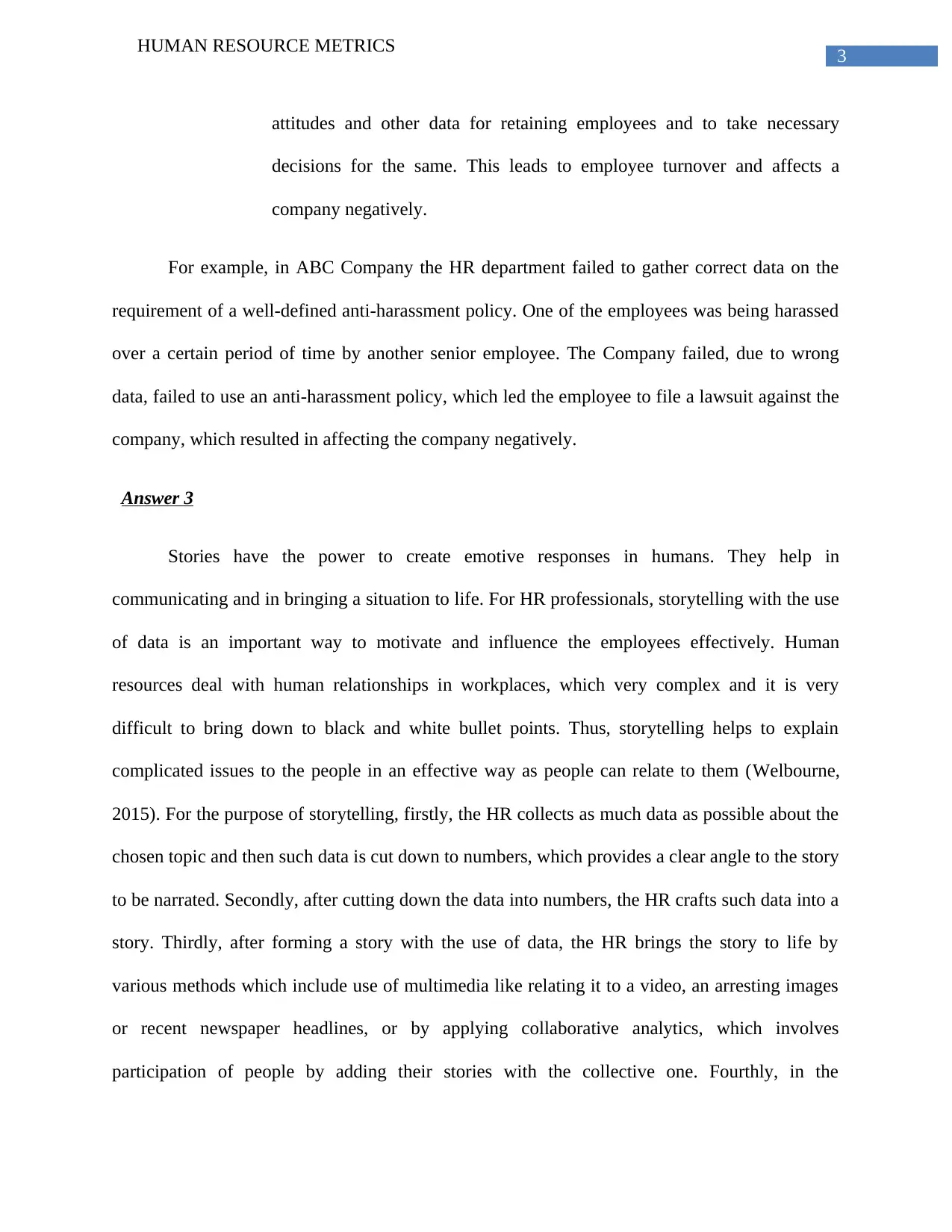
3
HUMAN RESOURCE METRICS
attitudes and other data for retaining employees and to take necessary
decisions for the same. This leads to employee turnover and affects a
company negatively.
For example, in ABC Company the HR department failed to gather correct data on the
requirement of a well-defined anti-harassment policy. One of the employees was being harassed
over a certain period of time by another senior employee. The Company failed, due to wrong
data, failed to use an anti-harassment policy, which led the employee to file a lawsuit against the
company, which resulted in affecting the company negatively.
Answer 3
Stories have the power to create emotive responses in humans. They help in
communicating and in bringing a situation to life. For HR professionals, storytelling with the use
of data is an important way to motivate and influence the employees effectively. Human
resources deal with human relationships in workplaces, which very complex and it is very
difficult to bring down to black and white bullet points. Thus, storytelling helps to explain
complicated issues to the people in an effective way as people can relate to them (Welbourne,
2015). For the purpose of storytelling, firstly, the HR collects as much data as possible about the
chosen topic and then such data is cut down to numbers, which provides a clear angle to the story
to be narrated. Secondly, after cutting down the data into numbers, the HR crafts such data into a
story. Thirdly, after forming a story with the use of data, the HR brings the story to life by
various methods which include use of multimedia like relating it to a video, an arresting images
or recent newspaper headlines, or by applying collaborative analytics, which involves
participation of people by adding their stories with the collective one. Fourthly, in the
HUMAN RESOURCE METRICS
attitudes and other data for retaining employees and to take necessary
decisions for the same. This leads to employee turnover and affects a
company negatively.
For example, in ABC Company the HR department failed to gather correct data on the
requirement of a well-defined anti-harassment policy. One of the employees was being harassed
over a certain period of time by another senior employee. The Company failed, due to wrong
data, failed to use an anti-harassment policy, which led the employee to file a lawsuit against the
company, which resulted in affecting the company negatively.
Answer 3
Stories have the power to create emotive responses in humans. They help in
communicating and in bringing a situation to life. For HR professionals, storytelling with the use
of data is an important way to motivate and influence the employees effectively. Human
resources deal with human relationships in workplaces, which very complex and it is very
difficult to bring down to black and white bullet points. Thus, storytelling helps to explain
complicated issues to the people in an effective way as people can relate to them (Welbourne,
2015). For the purpose of storytelling, firstly, the HR collects as much data as possible about the
chosen topic and then such data is cut down to numbers, which provides a clear angle to the story
to be narrated. Secondly, after cutting down the data into numbers, the HR crafts such data into a
story. Thirdly, after forming a story with the use of data, the HR brings the story to life by
various methods which include use of multimedia like relating it to a video, an arresting images
or recent newspaper headlines, or by applying collaborative analytics, which involves
participation of people by adding their stories with the collective one. Fourthly, in the
Paraphrase This Document
Need a fresh take? Get an instant paraphrase of this document with our AI Paraphraser
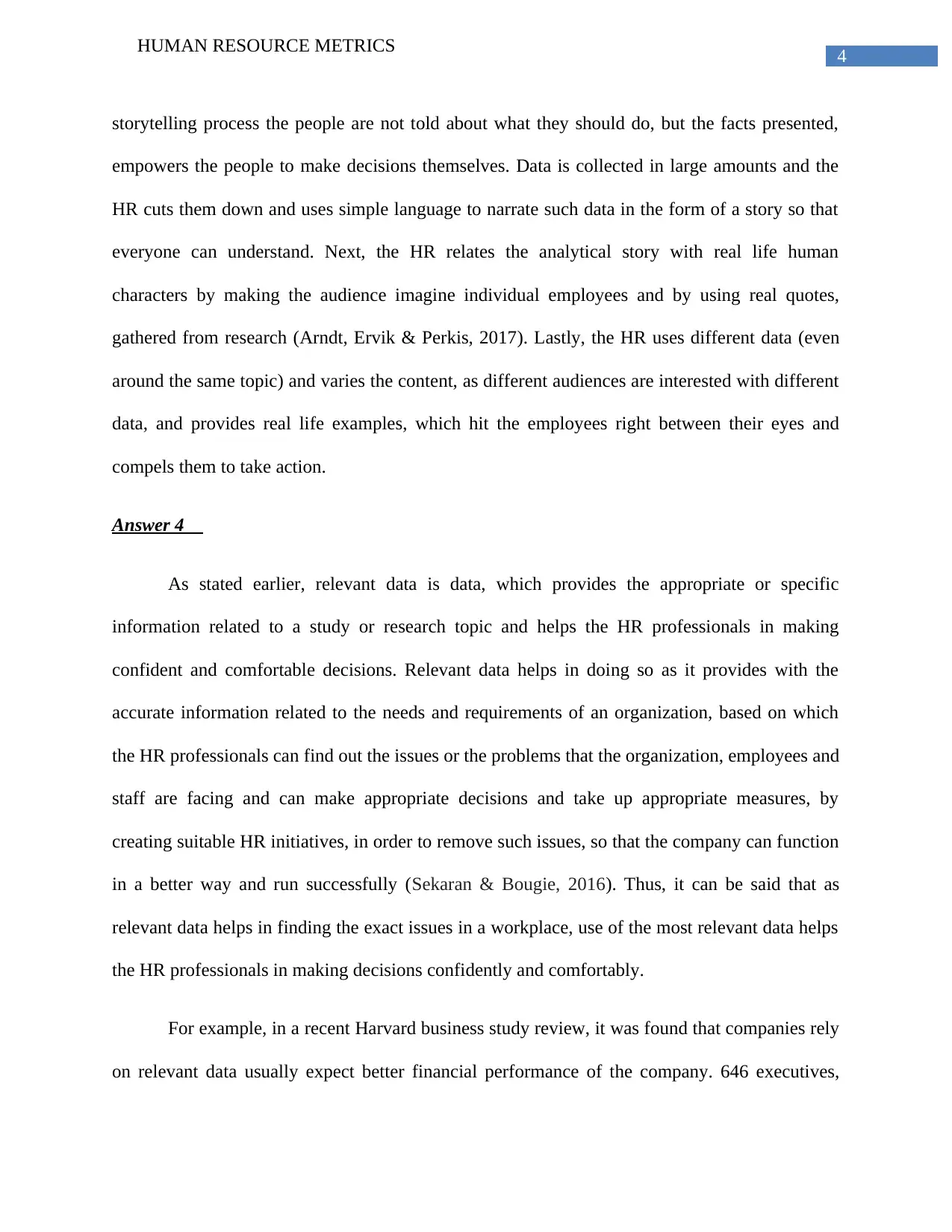
4
HUMAN RESOURCE METRICS
storytelling process the people are not told about what they should do, but the facts presented,
empowers the people to make decisions themselves. Data is collected in large amounts and the
HR cuts them down and uses simple language to narrate such data in the form of a story so that
everyone can understand. Next, the HR relates the analytical story with real life human
characters by making the audience imagine individual employees and by using real quotes,
gathered from research (Arndt, Ervik & Perkis, 2017). Lastly, the HR uses different data (even
around the same topic) and varies the content, as different audiences are interested with different
data, and provides real life examples, which hit the employees right between their eyes and
compels them to take action.
Answer 4
As stated earlier, relevant data is data, which provides the appropriate or specific
information related to a study or research topic and helps the HR professionals in making
confident and comfortable decisions. Relevant data helps in doing so as it provides with the
accurate information related to the needs and requirements of an organization, based on which
the HR professionals can find out the issues or the problems that the organization, employees and
staff are facing and can make appropriate decisions and take up appropriate measures, by
creating suitable HR initiatives, in order to remove such issues, so that the company can function
in a better way and run successfully (Sekaran & Bougie, 2016). Thus, it can be said that as
relevant data helps in finding the exact issues in a workplace, use of the most relevant data helps
the HR professionals in making decisions confidently and comfortably.
For example, in a recent Harvard business study review, it was found that companies rely
on relevant data usually expect better financial performance of the company. 646 executives,
HUMAN RESOURCE METRICS
storytelling process the people are not told about what they should do, but the facts presented,
empowers the people to make decisions themselves. Data is collected in large amounts and the
HR cuts them down and uses simple language to narrate such data in the form of a story so that
everyone can understand. Next, the HR relates the analytical story with real life human
characters by making the audience imagine individual employees and by using real quotes,
gathered from research (Arndt, Ervik & Perkis, 2017). Lastly, the HR uses different data (even
around the same topic) and varies the content, as different audiences are interested with different
data, and provides real life examples, which hit the employees right between their eyes and
compels them to take action.
Answer 4
As stated earlier, relevant data is data, which provides the appropriate or specific
information related to a study or research topic and helps the HR professionals in making
confident and comfortable decisions. Relevant data helps in doing so as it provides with the
accurate information related to the needs and requirements of an organization, based on which
the HR professionals can find out the issues or the problems that the organization, employees and
staff are facing and can make appropriate decisions and take up appropriate measures, by
creating suitable HR initiatives, in order to remove such issues, so that the company can function
in a better way and run successfully (Sekaran & Bougie, 2016). Thus, it can be said that as
relevant data helps in finding the exact issues in a workplace, use of the most relevant data helps
the HR professionals in making decisions confidently and comfortably.
For example, in a recent Harvard business study review, it was found that companies rely
on relevant data usually expect better financial performance of the company. 646 executives,

5
HUMAN RESOURCE METRICS
professionals and managers were surveyed all across the globe, which resulted in the findings
that a huge number of companies have using relevant data capture and analysis into their
decision making processes.
HUMAN RESOURCE METRICS
professionals and managers were surveyed all across the globe, which resulted in the findings
that a huge number of companies have using relevant data capture and analysis into their
decision making processes.
⊘ This is a preview!⊘
Do you want full access?
Subscribe today to unlock all pages.

Trusted by 1+ million students worldwide
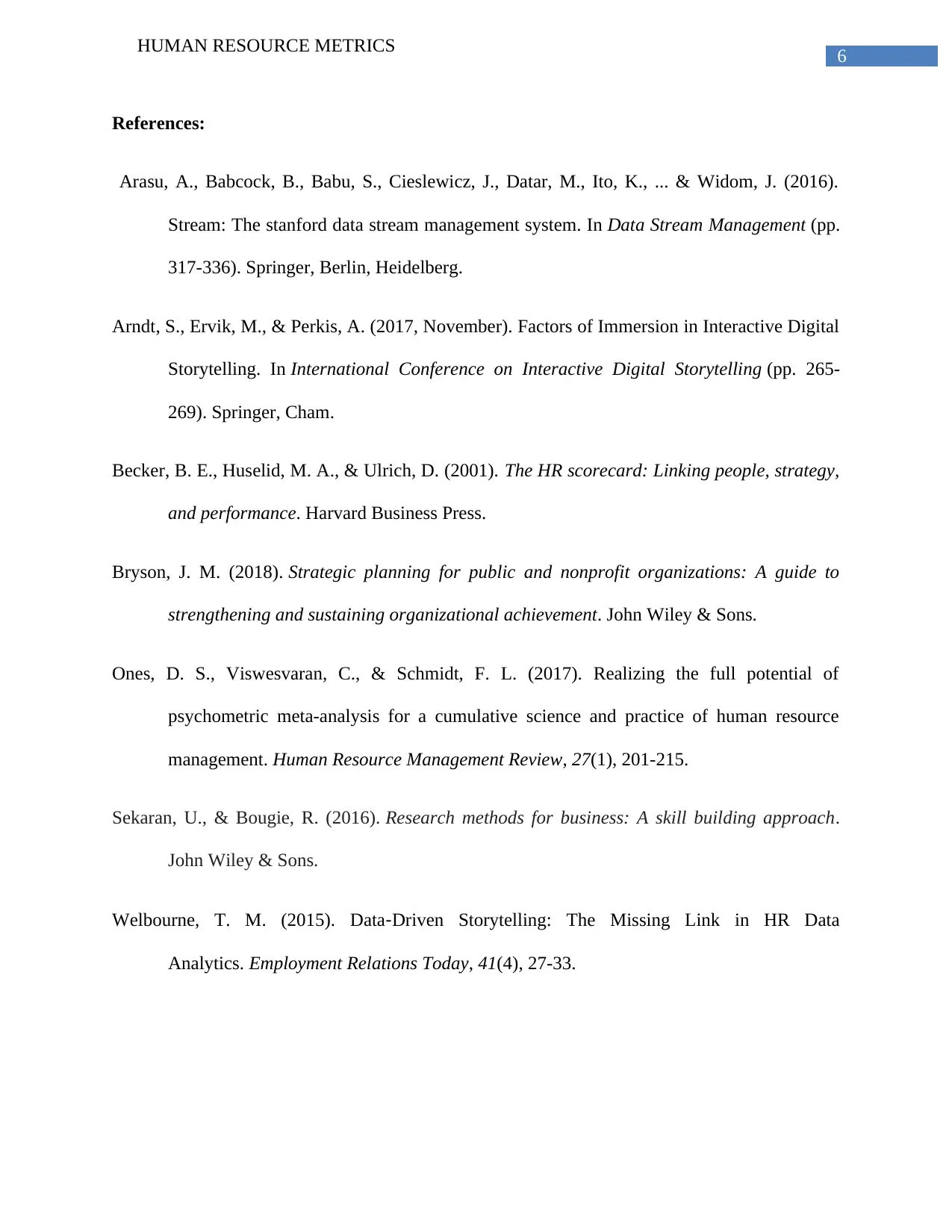
6
HUMAN RESOURCE METRICS
References:
Arasu, A., Babcock, B., Babu, S., Cieslewicz, J., Datar, M., Ito, K., ... & Widom, J. (2016).
Stream: The stanford data stream management system. In Data Stream Management (pp.
317-336). Springer, Berlin, Heidelberg.
Arndt, S., Ervik, M., & Perkis, A. (2017, November). Factors of Immersion in Interactive Digital
Storytelling. In International Conference on Interactive Digital Storytelling (pp. 265-
269). Springer, Cham.
Becker, B. E., Huselid, M. A., & Ulrich, D. (2001). The HR scorecard: Linking people, strategy,
and performance. Harvard Business Press.
Bryson, J. M. (2018). Strategic planning for public and nonprofit organizations: A guide to
strengthening and sustaining organizational achievement. John Wiley & Sons.
Ones, D. S., Viswesvaran, C., & Schmidt, F. L. (2017). Realizing the full potential of
psychometric meta-analysis for a cumulative science and practice of human resource
management. Human Resource Management Review, 27(1), 201-215.
Sekaran, U., & Bougie, R. (2016). Research methods for business: A skill building approach.
John Wiley & Sons.
Welbourne, T. M. (2015). Data‐Driven Storytelling: The Missing Link in HR Data
Analytics. Employment Relations Today, 41(4), 27-33.
HUMAN RESOURCE METRICS
References:
Arasu, A., Babcock, B., Babu, S., Cieslewicz, J., Datar, M., Ito, K., ... & Widom, J. (2016).
Stream: The stanford data stream management system. In Data Stream Management (pp.
317-336). Springer, Berlin, Heidelberg.
Arndt, S., Ervik, M., & Perkis, A. (2017, November). Factors of Immersion in Interactive Digital
Storytelling. In International Conference on Interactive Digital Storytelling (pp. 265-
269). Springer, Cham.
Becker, B. E., Huselid, M. A., & Ulrich, D. (2001). The HR scorecard: Linking people, strategy,
and performance. Harvard Business Press.
Bryson, J. M. (2018). Strategic planning for public and nonprofit organizations: A guide to
strengthening and sustaining organizational achievement. John Wiley & Sons.
Ones, D. S., Viswesvaran, C., & Schmidt, F. L. (2017). Realizing the full potential of
psychometric meta-analysis for a cumulative science and practice of human resource
management. Human Resource Management Review, 27(1), 201-215.
Sekaran, U., & Bougie, R. (2016). Research methods for business: A skill building approach.
John Wiley & Sons.
Welbourne, T. M. (2015). Data‐Driven Storytelling: The Missing Link in HR Data
Analytics. Employment Relations Today, 41(4), 27-33.
1 out of 7
Related Documents
Your All-in-One AI-Powered Toolkit for Academic Success.
+13062052269
info@desklib.com
Available 24*7 on WhatsApp / Email
![[object Object]](/_next/static/media/star-bottom.7253800d.svg)
Unlock your academic potential
Copyright © 2020–2025 A2Z Services. All Rights Reserved. Developed and managed by ZUCOL.





